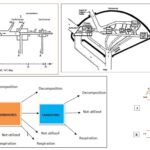Agricultural Microbiology 6 Views 1 Answers
Sourav PanLv 9July 24, 2025
What are the main strategies for improving the efficiency and cost-effectiveness of microbial cellulose degradation for industrial use?
What are the main strategies for improving the efficiency and cost-effectiveness of microbial cellulose degradation for industrial use?
Please login to save the post
Please login to submit an answer.
Sourav PanLv 9July 24, 2025
Improving the efficiency and cost-effectiveness of microbial cellulose degradation is crucial for unlocking the full potential of lignocellulosic biomass. Key strategies involve:
- Strain Development and Improvement:Discovery of Novel Species and Enzymes: Continuously identifying and characterizing new lignocellulose-degrading microorganisms (bacteria, fungi, and their unique enzymes) from diverse ecosystems (e.g., gut microbiomes, thermophilic environments) that possess superior degradation capabilities.
- Genetic Modification (Strain Engineering):Random Mutagenesis: Using chemical mutagens or radiation (UV, gamma-rays) to induce random mutations in microbial genomes, followed by high-throughput screening to select hyper-producing or more efficient strains.
- Recombinant DNA Technology: Introducing specific cellulase-producing genes from different sources into host organisms to enhance enzyme yield or introduce desirable traits. This can involve increasing gene copy numbers.
- Site-Directed Mutagenesis: Precisely altering specific amino acid sequences in enzymes to improve properties like activity, thermostability, pH profile, or substrate specificity.
- Protoplast Fusion: Fusing the protoplasts of two genetically different strains to combine desirable characteristics, such as disease resistance, rapid growth, or enhanced enzyme production.
- Optimization of Fermentation Technology:Solid-State Fermentation (SSF): Often preferred for fungal cellulase production as it mimics natural habitats, potentially leading to higher enzyme yields with lower substrate and energy utilization.
- Submerged Fermentation (SmF): Allows for easier control of environmental factors (temperature, pH, aeration) and simpler product recovery, making it suitable for large-scale production.
- Biofilm Fermentation: An advanced form where microbial cells adhere to surfaces, potentially leading to different physiological states and enhanced enzyme production.
- Process Parameter Optimization: Systematically adjusting physical (temperature, pH, incubation time, moisture) and chemical (carbon and nitrogen sources, mineral supplements) conditions to maximize cellulase production and activity. Using cheap and abundant cellulosic waste as a carbon source is particularly important for cost-effectiveness.
- Enzyme Engineering and Immobilization:Enhancing Enzyme Stability: Engineering enzymes for improved thermostability (e.g., active at higher temperatures) allows for more robust industrial processes and efficient enzyme recycling.
- Immobilization: Attaching cellulases to solid support materials (e.g., synthetic polymers, nanoparticles) to improve their catalytic activity, thermal stability, reusability, and easier separation from the product, significantly reducing processing costs.
- Designer Cellulosomes: Constructing artificial multi-enzyme complexes that mimic natural cellulosomes. These “designer cellulosomes” can integrate diverse enzymes from multiple species (both cellulosomal and non-cellulosomal) to enhance synergistic degradation. Improving the structural stability and compatibility of cohesin-dockerin interactions in these designer complexes is an active area of research.
- Interdisciplinary Approaches: Integrating insights from ecology, microbiology, biochemistry, and engineering to gain a comprehensive understanding of microbial carbon cycling and develop holistic solutions.
0
0 likes
- Share on Facebook
- Share on Twitter
- Share on LinkedIn
0 found this helpful out of 0 votes
Helpful: 0%
Helpful: 0%
Was this page helpful?




